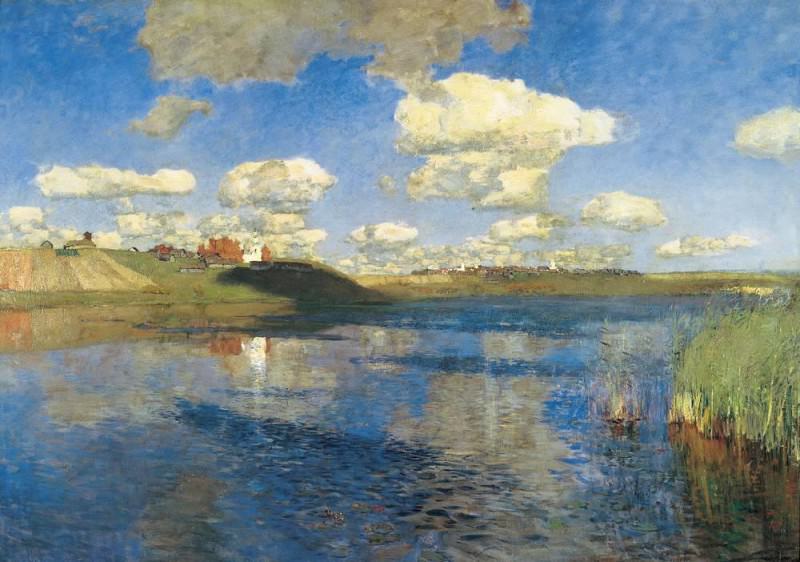Lake. Russ. 1899-1900 Isaac Ilyich Levitan (1860-1900)
Isaac Ilyich Levitan – Lake. Russ. 1899-1900
Edit attribution
Download full size: 1000×702 px (0,1 Mb)
Painter: Isaac Ilyich Levitan
This last painting by Levitan was painted in 1895. "Lake Rus’" is the painter’s major work of the late period. The artist never completed this work as he died. But even in this unfinished form, the picture makes a simply grand impression on all viewers. The sunny day, its incredible freshness and peculiar brightness, is conveyed with a special immediacy that is almost impressionistic. The viewer sees magnificent golden clouds floating across the sky, intricately reflected in the lake.
Description of Isaac Levitan’s painting "The Lake. Russia."
This last painting by Levitan was painted in 1895.
"Lake Rus’" is the painter’s major work of the late period. The artist never completed this work as he died. But even in this unfinished form, the picture makes a simply grand impression on all viewers. The sunny day, its incredible freshness and peculiar brightness, is conveyed with a special immediacy that is almost impressionistic. The viewer sees magnificent golden clouds floating across the sky, intricately reflected in the lake. On the shore one sees bell towers of bright white, lush green meadows, and autumn trees. All this fills us with the belief that a very joyful and necessarily good future awaits Russia.
Levitan’s painting is a kind of synthesis of all observations and impressions of the artist on the nature of his land.
Above this canvas, the artist worked incredibly long and most importantly inspired. For this painting he made many sketches and studies. Very often he went to the lakes in Tver province, which became the nature of his masterpiece.
Levitan masterfully combines the rich colors of summer with the exuberance of shades of autumn nature. The artist’s idea is that this is how nature should be in a rare enough moments of its true happiness. The viewer is presented with an incredibly romantic picture that sounds like a lyrical song.
It is important that the sky is not just the background of the picture. There is an overwhelming feeling that the clouds are not just floating and catching up with each other, but as if they go beyond the canvas. It is the clouds that are the most expressive part of this grandiose landscape.
The space is encompassed on such a scale that a true panorama is created. The clouds move, enhancing this incredible breadth.
All of the colors of the painting are unusually bright and clear. The clouds are far from just white. They are slightly purple and slightly yellowish where the sun’s rays illuminate them.
The entire canvas is created by large width strokes that generalize all the objects.
The painter is trying to combine a kind of ornamentality and true monumentality, the complexity and generalization of the depicted him, psychologism and subtlety of the transitions between color and light.
Кому понравилось
Пожалуйста, подождите
На эту операцию может потребоваться несколько секунд.
Информация появится в новом окне,
если открытие новых окон не запрещено в настройках вашего браузера.
You need to login
Для работы с коллекциями – пожалуйста, войдите в аккаунт (open in new window).




















COMMENTS: 1 Ответы
Щемящая грусть о чём то утраченном.
You cannot comment Why?
On the left bank of the lake, a gentle slope leads up to a small village or settlement. Several buildings, some appearing to be made of brick and others of lighter materials, are clustered together. A larger, reddish-brown building or structure stands out prominently on the rise. The land is a patchwork of green and brown, with hints of cultivated fields.
The water of the lake is a deep blue, mirroring the sky and the clouds with remarkable clarity. There are subtle ripples on the surface, and in the foreground to the right, tall reeds or grasses grow along the waters edge, their green hues adding a touch of wildness to the otherwise ordered scene.
Subtextually, the painting evokes a sense of peace, tranquility, and the beauty of rural Russia. The vastness of the sky and the lake can symbolize eternity and the sublime, while the small settlement on the shore represents human life and community in harmony with nature. The time of day, suggested by the light on the clouds, might also imply a contemplative mood or the cyclical nature of time. The reflections in the water can be interpreted as a meditation on reality and illusion, or the mirroring of the spiritual in the material world. The overall impression is one of quiet grandeur and a deep connection to the Russian landscape.